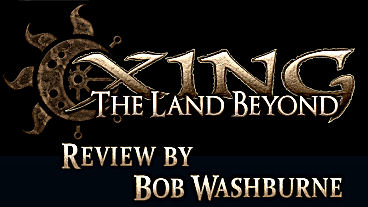
Xing: The Land Beyond Review
Gorgeous graphics, original puzzles and optional VR. A must-own for 3D goggle users.







Genre: Puzzle-Centric Adventure
Release date: September 21, 2017
Xing: The Land Beyond was created by independent developers White Lotus Studios and fueled by a successful Kickstarter campaign. (Yes, I was a backer.) It can be played with or without virtual reality. I played it with, so that is how I will be reviewing the game.
Xing is a puzzle-centric game. The graphics are beautiful. The stories are quaint. But make no mistake, you come to Xing for the puzzles.
Puzzles are the most difficult part of an adventure game to design. Graphic designers and 3D artists are easy to find, but puzzle designers are few and far between. This makes Xing special as it is loaded with original puzzles. While there are a few “toss the flaming coconut into the kangaroo’s pouch” challenges, most of the puzzles are logical and self-contained. There are no keys hidden under rocks or clues spray painted inside garbage can lids. All puzzles can be solved with just a little thought. And while they start off easy, they progress in difficulty throughout the game.
As the game starts you have just died and are going to the light -– a really cool trip in VR. You land in a barren white area where you are introduced to the navigation system. Once you are familiar with the controls you are free to proceed through the doorway and into the garden.
The garden is an oasis with pools and portals to four other worlds (hmm, a hub connecting to four other worlds… Where have I seen this before?). Here you meet a stone creature who claims to be your old friend. He has been collecting souls, but four managed to get away from him. So now you must go to the four worlds and retrieve them. He unlocks the first portal and the game begins in earnest.
Now, lest you think that this is one of those preachy believe-my-way-or-you’re-going-to-hell games, let me assure you that the whole afterlife shtick is just an excuse for the game mechanics. To make the puzzles work it is important that you not be able to swim, not be able to fly and not be able to die. Yet you can change the weather and environment just by stepping into sacred circles. How do you explain this lake of ability mixed with magic? Easy! It’s the afterlife. That’s just how things are.
So, what is so great about these puzzles? Well, they mostly center around rotating bridges and sliding obelisks. When you enter the first world you are given the ability to change day into night and back again. You soon find out that certain things can only be moved during the day and others only at night. And you can only make the change from one of the sacred circles. This gives you a set of puzzles where things must be done in the right order in order to pass beyond. What that order is can be figured out with just a bit of thought.
Once you complete that world old Basalt Breath opens the next portal for you and you are granted a different effect on the environment as well as another mechanic (like bouncing drums). These are added to your previous capabilities so while the last world only had one variable to work with, you now have three. The third world has five abilities to work with and by the time you get to the fourth world you will be juggling nine or more, depending on how you count. That leads to some rather convoluted puzzles.
So what is the purpose to all of this? What is the goal? Well, remember those souls you were supposed to collect. Every life has a story and the story for each of these lives has been condensed into a dozen or so scrolls. You must search out each scroll (they are easy to find) and read its poem to complete the level. Don’t ask me why or how this collects that soul or whether I should be disturbed at what I am doing.
Also, each world has six or seven runes to find. Finding these will decode the many signs scattered around the garden. Each rune will be converted to its English letter equivalent. Sometimes these runes require the solving of additional puzzles in order to get to them. They are totally optional, but surely you would not leave the game only partially completed, would you?
The puzzles are there to block your path. They must be solved in order for you to progress to the next area.
Needless to say, the game is very linear. Capabilities and difficulty levels are carefully managed so you should always be able to handle the task at hand.
And while the puzzles are all logical and can be figured out without additional clues, it is easy to get distracted. The landscapes are gorgeous. People who have only played it in 2D have said it is one of the most beautiful games they have ever played. In VR it is simply breathtaking. So exploration is a must. Not that you will find any clues up on the canyon walls, but the view will be amazing.
There is also some lovely background music. Each world has its own theme which only comes out during special times, like entering a new area, and then fades out before you get tired of it. This can be so subtle that you might not notice that the music was gone until it starts back up again.
The stories are all simple yet engaging. They usually have a lesson to teach. After the second world is completed a small park opens up which has the stories of another dozen souls. These are optional. There are no puzzles to solve in the park. Just beautiful landscapes to take in while you collect the simple story.
So, with all this good stuff is there anything to complain about? Unfortunately, yes. There are a few minor annoyances.
The biggest is the navigation system while in VR. To turn you have to look straight ahead, point the left controller in the direction you want to face and pull the trigger. The developers claimed that their beta testers loved it, but I could never get used to it. Even towards the end of the game I was breaking immersion to focus on the controls. And immersion is the whole point of VR.
Also, I found tossing things to be difficult while in VR. You point your controller at an object, hold the trigger in to grab it, make a tossing motion with your hand and release the trigger to release the object. There are several places in the game where you have to toss things at targets, but my throws never seemed to go where I intended.
However, in 2D the controllers have a “target site” which shows you exactly where the object will go when you release it. This is quite easy. So there were several times when I would just exit the game, start it back up in 2D, toss the object (perfectly the first time) and then shut it down to start back up in 3D. Again, this was a big distraction.
Finally, there is no way in the game to reset a puzzle short of resetting the whole level. Sometimes it would take me a bit of fiddling before I figured out the solution. By then objects and controls could be set all over the place and would have to be returned to their original positions to implement the solution. This could sometimes be more difficult that the puzzle itself.
None of these, however, were game-breakers. I enjoyed the game a lot and while it might take about five hours to complete if you know all the solutions beforehand, I took about 15 hours to finish it.
Bottom line -– if you like puzzles and you like eye candy, you will like this game. I consider it to be a must-own whether you play it 2D or 3D. And in 3D it has to be in the top five along with Obduction and The Vanishing of Ethan Carter.
|
+ Breathtaking VR landscapes
+ Original puzzles which are solvable with logic
+ You can switch your game back and forth between 2D and VR
+/- Linear game play – Navigation is awkward in VR
– Throwing objects is awkward in VR
– Individual puzzles cannot be reset |

|
System Requirements
Memory: 4 GB RAM

Leave a Reply